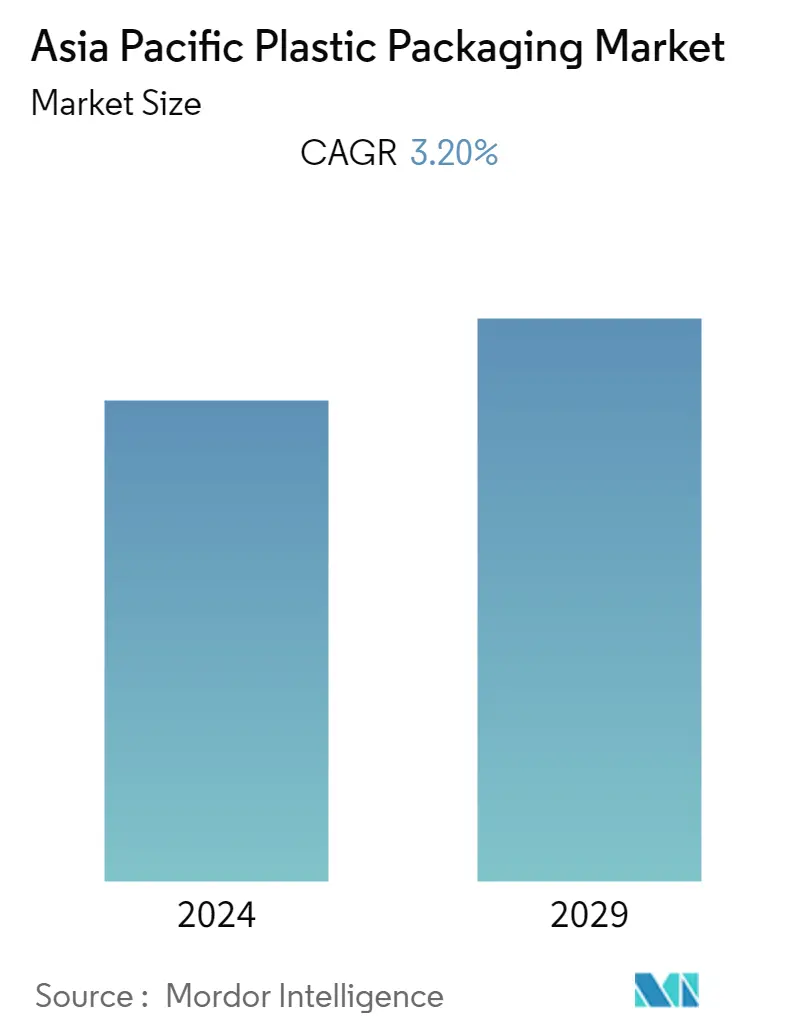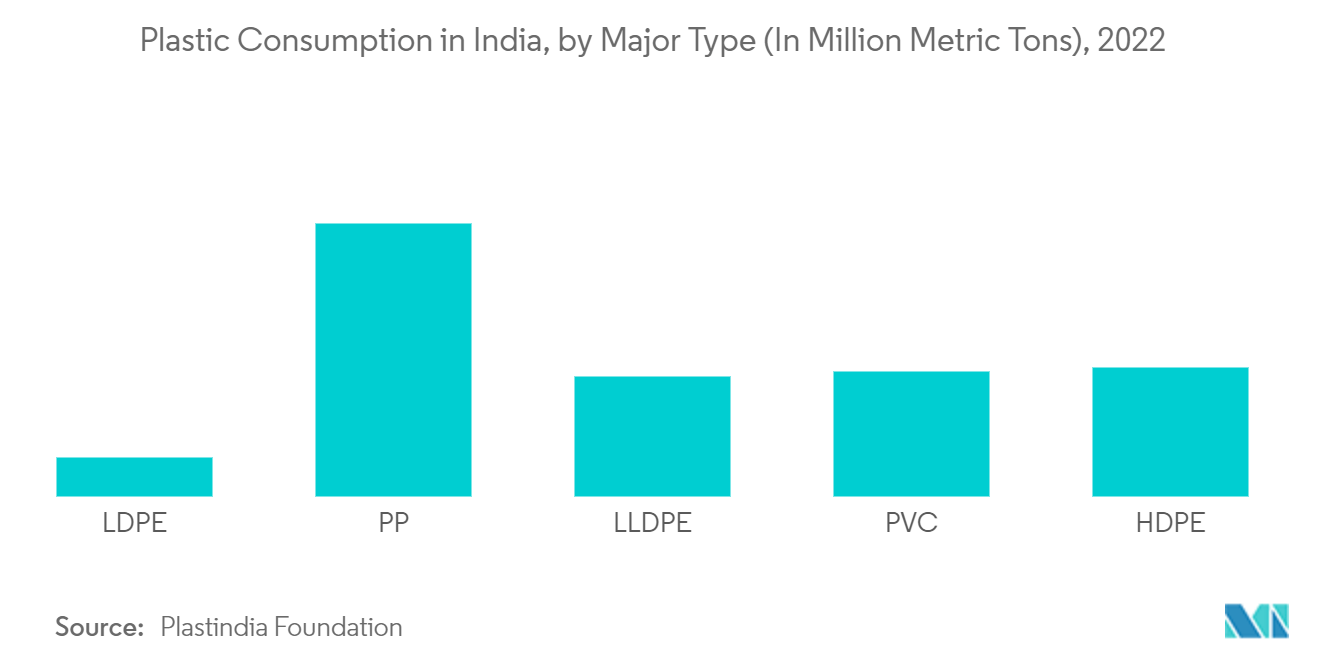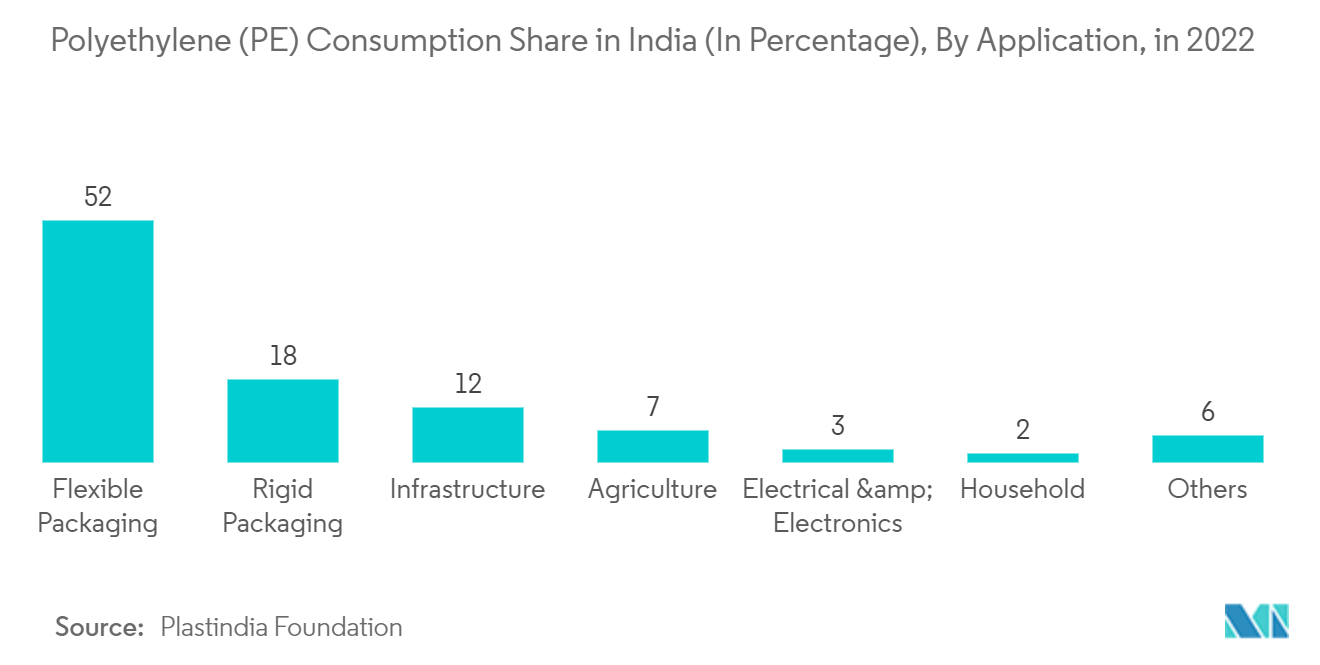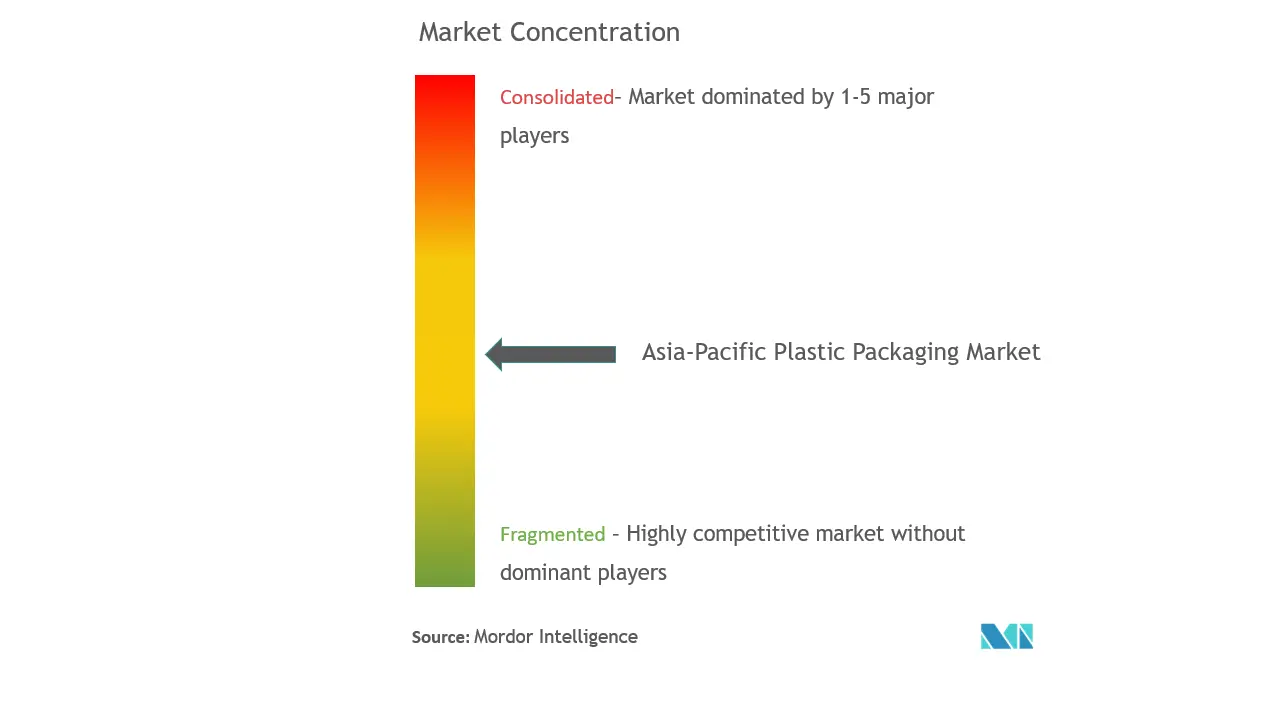Asia Pacific Plastic Packaging Market Size

| Study Period | 2019 - 2029 |
| Base Year For Estimation | 2023 |
| Forecast Data Period | 2024 - 2029 |
| Historical Data Period | 2019 - 2022 |
| CAGR | 3.20 % |
| Market Concentration | Medium |
Major Players
*Disclaimer: Major Players sorted in no particular order |
Asia Pacific Plastic Packaging Market Analysis
The Asia-Pacific plastic packaging market is anticipated to grow with a CAGR of 3.2% during the forecast period. Since the Covid-19 pandemic started, consumers and businesses have had to alter how they view packaging health and safety. Since the pandemic early days, single-use plastic were gaining importance. Consumers were concerned that reusable packaging would increase the transmission risk.
- Plastic packaging became popular among consumers over other products, as plastic is lightweight and unbreakable, making it easier to handle. Even significant manufacturers prefer plastic packaging, owing to the lower production cost. Moreover, introducing polymers, such as polyethylene terephthalate (PET) and high-density polyethylene (HDPE), is expanding plastic bottle applications. The market is witnessing an increasing demand for PET bottles.
- The industries where plastic bottles and jars are mainly used in the market include food and beverage, cosmetics and personal care, and healthcare. The beverage sector market for plastic bottles is anticipated to witness rapid growth, owing to the demand for bottled water and non-alcoholic beverages.
- In February last year, the Coca-Cola Company set an industry-leading objective to increase its reusable packaging usage significantly. By 2030, the firm hopes to have at least 25% of all beverages sold in refillable/returnable plastic bottles or refillable containers through a traditional fountain or Coca-Cola Freestyle dispensers across its portfolio of brands. Such developments are expected to increase the market demand for plastic bottle manufacturing.
- Additionally, the e-commerce industry's rapid expansion is anticipated to create new opportunities for market expansion. To cut transportation costs, e-commerce enterprises favor lightweight and flexible packaging options. The sector is expected to increase as more people shop online for everyday fresh foods, FMCG products, electrical devices, and clothing.
- Plastic packaging demand continues to surge even though serious concerns about its environmental impact are raised. However, the market will face challenges from government regulations and consumer demand, pushing manufacturers to look for biodegradable plastic packaging solutions derived from sustainable sources.
- The COVID-19 pandemic indicated that demand for clean bottled water, nutritious juices, and beverages is at an all-time high, despite businesses limiting the amount of each customer's purchase. Although most of these containers were single-use, many firms are attempting to increase the use of recycled plastic content to satisfy consumer concerns.
Asia Pacific Plastic Packaging Market Trends
This section covers the major market trends shaping the APAC Plastic Packaging Market according to our research experts:
Cost-effectiveness & increased shelf-life of the product to drive the growth of the market
- Plastic packaging is cheaper and more convenient than packaging made from other materials. It is commonly used for multiple purposes in many industries, including food and beverages, healthcare, cosmetics, etc. Also, according to Plastindia Foundation, In India, there was a total demand for primary plastics in the range of 15 million tons (excluding engineering plastics and thermosets), with polyethylene varieties accounting for around six million metric tons of that total. During that year, polypropylene was the primary commodity plastic with an enormous demand.
- Also, according to the Flexible Packaging Association, flexible packaging is mainly used for food, contributing to more than 60% of the total market. The flexible packaging industry is witnessing healthy growth, as the industry was able to implement innovative solutions for the many packaging challenges it faced. According to IBEF, the Indian food and grocery market is the sixth-largest global, with retail contributing 70% of the sales. The Indian food processing industry accounted for 32% of the country's total food market, one of the largest industries in India, ranked fifth in terms of production, consumption, export, and expected growth.
- Additionally, EPS is lightweight, durable, thermally efficient, and versatile. It also includes exceptional shock-absorbing characteristics, making it ideal for storing and transporting fragile and expensive items, such as electronic equipment, wine, chemicals, and pharmaceutical products. The thermal insulation and moisture-resistant properties of EPS enable a shelf-life extension of perishable products, such as soft fruits, vegetables, and seafood.
- Moreover, according to the Australian Packaging Covenant Organization (APCO), the total amount of EPS packaging consumed in Australia every year is estimated to be more than 44,000 metric tons, broken down into applications of 20,000 metric tons for packaging of electrical and electronic products and 24,000 metric tons for another packaging.

Rigid Plastic Packaging to Hold the Significant Market Share
- Rigid plastic packaging containers provide unique benefits, such as high impact strength, stiffness, and barrier properties, which have expanded rigid plastic packaging in recent years. Also, new and improved tough PE resins are introduced due to sustained demand. For instance, Braskem launched a new polyethylene (PE) resin in the rigid packaging segment the previous year. Braskem provided the market with a new product option, HD1954M, which is a part of the Rigeofamily portfolio. High-density polyethylene offers a combination of high rigidity, 100% recyclable grade, good impact strength, and Environmental Stress Cracking (ESCR), rendering packaging optimization and productivity gains.
- The introduction of polyethylene terephthalate (PET) and high-density polyethylene (HDPE) polymers expanded plastic bottling applications. High-density polyethylene plastic bottles are among the popular packaging choices for the fresh juice and milk market.
- In the rigid packaging industry, PET is used for plastic bottles for soft drinks, water, juice, sports drinks, beer, mouthwash, catsup, salad dressing, food jars, and microwavable food trays. Also, PET is one of Japan's most widely used materials for manufacturing plastic bottles. PET bottles are also used for packaging carbonated drinks in the country. An average person in the country buys 183 PET bottles per year. Other packaging materials, such as HDPE and PP, are also witnessing rising adoption rates, with companies looking to attract more consumers by offering different products.
- Also, several companies are making strategic acquisitions to tap into the growing market of the plastic packaging industry. For instance, in the previous year, TricorBrausentered an agreement to acquire Cormack Packaging, expected to establish the former's footprint in New Zealand and Australia and serve the food and beverage, pharmaceutical, personal care, industrial, and household cleaning industries with rigid packaging.
- Packaging is India's primary polyethylene (PE) application in the last financial year. The flexible packaging segment accounted for 52 % of PE demand in the same year, while rigid packaging made up 18 % of the total market.

Asia Pacific Plastic Packaging Industry Overview
The Asia Pacific Plastic Packaging Market is highly competitive and includes several significant players. A few players enjoy better market goodwill and extended geographical recognition and presence. The major players, who have a relatively prominent market share, focus on expanding their customer base across the end-user industries.
- March 2022: Tosoh, a Japanese petrochemical producer, aims to develop its chemical recycling technology to generate raw monomers from mixed plastics, targeting to establish the technology by the end of March 2025.
Asia Pacific Plastic Packaging Market Leaders
-
berry plastics corporation
-
Sonoco Products Company
-
amcor limited
-
DS Smith PLC
-
mondi group
*Disclaimer: Major Players sorted in no particular order

Asia Pacific Plastic Packaging Market News
- August 2022: Manjushree Technopack entered an agreement to acquire the business operations and manufacturing facilities of Hitesh Plastics. The acquisition will enhance the company's caps and closures market and strengthen its rigid plastic packaging business. Manjushree caters to packaging requirements across FMCG, F&B, home care, personal care, agrochemicals, pharmaceutical, and liquor industries. With its current manufacturing capacity of 1,90,000 MT per annum and an annual turnover of USD 250 million, Manjushree is one of India's prominent rigid plastics packaging companies.
- June 2022: Coca-Cola India announced that it aimed to achieve 100% recovery and recycling of post-consumer packaging, primarily bottles, in the next two to three years. The company's global campaign, world without waste, seeks to collect and recycle every bottle that can sell by 2030. Overall, rigid plastic packaging is expected to witness growth in the studied segment throughout the forecast period, with more focus on recyclability and sustainability trends shaping the market.
Asia Pacific Plastic Packaging Market Report - Table of Contents
1. INTRODUCTION
- 1.1 Study Assumptions and Market Definition
- 1.2 Scope of the Study
2. RESEARCH METHODOLOGY
3. EXECUTIVE SUMMARY
4. MARKET INSIGHTS
- 4.1 Market Overview
- 4.2 Industry Value Chain Analysis
-
4.3 Industry Attractiveness - Porter's Five Forces Analysis
- 4.3.1 Bargaining Power of Suppliers
- 4.3.2 Bargaining Power of Buyers/Consumers
- 4.3.3 Threat of New Entrants
- 4.3.4 Threat of Substitute Products
- 4.3.5 Intensity of Competitive Rivalry
- 4.4 Assessment of COVID-19 Impact on the Industry
5. MARKET DYNAMICS
-
5.1 Market Drivers
- 5.1.1 Cost-Effectiveness & Increased Shelf-Life Of The Product
- 5.1.2 Downsizing Of Packaging
-
5.2 Market Restraints
- 5.2.1 Stringent Environmental Regulations
6. MARKET SEGMENTATION
-
6.1 By Type
- 6.1.1 Rigid Plastic Packaging
- 6.1.2 Flexible Plastic Packaging
-
6.2 By Material
- 6.2.1 Bi-orientated Polypropylene (BOPP)
- 6.2.2 Cast polypropylene (CPP)
- 6.2.3 Ethylene Vinyl Alcohol (EVOH)
- 6.2.4 Polyethylene (PE)
- 6.2.5 Polyethylene Terephthalate (PET)
- 6.2.6 Polypropylene (PP)
- 6.2.7 Polystyrene (PS) and Expanded Polystyrene (EPS)
- 6.2.8 Polyvinyl Chloride (PVC)
- 6.2.9 Other Materials
-
6.3 By Product
- 6.3.1 Bottles and Jars
- 6.3.2 Trays and containers
- 6.3.3 Pouches
- 6.3.4 Bags
- 6.3.5 Films & Wraps
- 6.3.6 Other Products
-
6.4 By End-user Industry
- 6.4.1 Food
- 6.4.2 Beverage
- 6.4.3 Healthcare
- 6.4.4 Cosmetics and Personal Care
- 6.4.5 Other End-user Industries
-
6.5 By Country
- 6.5.1 China
- 6.5.2 India
- 6.5.3 Japan
- 6.5.4 Australia
- 6.5.5 South Korea
- 6.5.6 Rest of Asia Pacific
7. COMPETITIVE LANDSCAPE
-
7.1 Company Profile
- 7.1.1 Mondi Group
- 7.1.2 Berry Plastics Corporation
- 7.1.3 Sonoco Products Company
- 7.1.4 Amcor Limited
- 7.1.5 DS Smith PLC
- 7.1.6 Bemis Company, Inc.
- 7.1.7 NatureWorks LLC
- 7.1.8 Reynolds Group Holdings Ltd (Packaging Finance Limited)
- 7.1.9 ALPLA-Werke Alwin Lehner GmbH & Co. KG
- 7.1.10 Consolidated Container Company
8. INVESTMENT ANALYSIS
9. FUTURE OF THE MARKET
** Subject To AvailablityAsia Pacific Plastic Packaging Industry Segmentation
Plastics are used in packaging materials, such as food, beverage, and oil. Plastics are used mainly because of their performance, cost-effectiveness, and durability. Plastics can be of different grades and different material combinations based on the type of product being packed, like polyethylene, polypropylene, polyvinyl chloride, etc.
The market study tracks the demand for plastic packaging through the revenue derived from selling rigid and flexible plastic packaging products. The study also follows the effects of regulations and market drivers on growth and factors hindering the market growth. Asia-Pacific Plastic Packaging Market is segmented by type (rigid plastic packaging and flexible plastic packaging ), material (Bi-orientated Polypropylene (BOPP), Cast Polypropylene (CPP), Ethylene Vinyl Alcohol (EVOH), Polyethylene (PE), Polyethylene Terephthalate (PET), Polypropylene (PP), Polystyrene (PS) and Expanded Polystyrene (EPS), Polyvinyl Chloride (PVC), and other materials), product (bottles and jars, trays and containers, pouches, bags, films & wraps, and other products), end-user industry (food, beverage, healthcare, cosmetics and personal care, and other end-use industries) and country (China, India, Japan, Australia, South Korea, and rest of Asia-Pacific).
The market sizes and projections are USD million for all the mentioned segments.
| By Type | Rigid Plastic Packaging |
| Flexible Plastic Packaging | |
| By Material | Bi-orientated Polypropylene (BOPP) |
| Cast polypropylene (CPP) | |
| Ethylene Vinyl Alcohol (EVOH) | |
| Polyethylene (PE) | |
| Polyethylene Terephthalate (PET) | |
| Polypropylene (PP) | |
| Polystyrene (PS) and Expanded Polystyrene (EPS) | |
| Polyvinyl Chloride (PVC) | |
| Other Materials | |
| By Product | Bottles and Jars |
| Trays and containers | |
| Pouches | |
| Bags | |
| Films & Wraps | |
| Other Products | |
| By End-user Industry | Food |
| Beverage | |
| Healthcare | |
| Cosmetics and Personal Care | |
| Other End-user Industries | |
| By Country | China |
| India | |
| Japan | |
| Australia | |
| South Korea | |
| Rest of Asia Pacific |
Asia Pacific Plastic Packaging Market Research FAQs
What is the current Asia Pacific Plastic Packaging Market size?
The Asia Pacific Plastic Packaging Market is projected to register a CAGR of 3.20% during the forecast period (2024-2029)
Who are the key players in Asia Pacific Plastic Packaging Market?
berry plastics corporation, Sonoco Products Company, amcor limited, DS Smith PLC and mondi group are the major companies operating in the Asia Pacific Plastic Packaging Market.
What years does this Asia Pacific Plastic Packaging Market cover?
The report covers the Asia Pacific Plastic Packaging Market historical market size for years: 2019, 2020, 2021, 2022 and 2023. The report also forecasts the Asia Pacific Plastic Packaging Market size for years: 2024, 2025, 2026, 2027, 2028 and 2029.
Asia Pacific Plastic Packaging Industry Report
Statistics for the 2024 Asia Pacific Plastic Packaging market share, size and revenue growth rate, created by Mordor Intelligence™ Industry Reports. Asia Pacific Plastic Packaging analysis includes a market forecast outlook 2029 and historical overview. Get a sample of this industry analysis as a free report PDF download.



